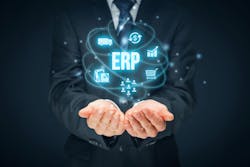Business dynamics change quickly. In the food and beverage industry, for example, there are new consumer demands, shifts in the supply chain and ever-evolving safety and environmental regulations to adhere to. In life sciences, there’s quality control and patient safety mandates, increasing cost pressures and a move to new production methods, such as smaller batches for cell therapy or more efficient continuous processing techniques. CPGs are dealing with the Amazon effect, which means building out e-commerce channels. And, automotive manufacturers are figuring out how to design smarter vehicles that are more affordable.
It doesn’t matter what the industry is, because business models are changing across the board. That means the technology architecture and applications that are supporting manufacturing operations and enterprise applications must be able to change too, adjusting based on business needs.
“We’ve spent a lot of time looking at vertical industries, and it’s clear that the way they do business, the products they produce, how they produce them, and who they sell to will likely change at a pace faster than ever seen before,” said Carter Lloyds, senior vice president and CMO at QAD, an enterprise resource planning (ERP) systems company. “When we look back at the history of enterprise apps, they were not designed to deal with change.” But that’s not reflective of today’s business environment, and, therefore, it is not okay anymore, he said. “The system will only last a few years before getting out of sync between what was designed and what is required.”
With the understanding that ERP must evolve to support future business, QAD set out on a multi-year mission four years ago to change the ERP experience. In essence, what they’ve developed over that period of time amounts to “easy ERP.” Conceived in 2014, the project is called "Channel Islands” and has been rolled out in phases—each addressing specific characteristics.
The first phase, unveiled in 2015, included a complete rewrite of the underlying architecture using standardized application program interfaces (APIs). The underlying business logic of the ERP platform did not change, but the way the logic was presented did, providing more flexibility to interact and connect with third-party software.
In 2016, phase two came along, delivering a collaborative framework, role-based dashboards and real-time metrics to help managers make fact-based decisions. Part of the new user experience (UX) includes contextual insight, which automatically knows what is important to the user and draws their attention to it on the screen. And last year, QAD rolled out phase three, which was focused on usability and mobility. It also provided deeper vertical industry focus and compliance capabilities that track country and local regulations for financial reporting and taxation purposes.
Over the years, the company has been testing the enterprise applications with early adopters and adding functionality along the way, culminating in a big reveal that marks a new era of ERP. Last month, the company announced the latest version of QAD Cloud ERP, which includes the general availability of the Channel Islands project. Within this release are enhancements to embedded analytics, customer and service management, financials, asset management and the supply chain.
According to Lloyds, the new version is designed to allow the user to upgrade functionality as needed. It also adds the ability to trigger logic and extend business modules in a “low code” environment. “This means you don’t need to hire developers to make changes to the software,” he said. “It is no longer about customizations but extensions, which does not create lock-in.”
In addition, the embedded analytics are a critical element to support the service-oriented business models that customers are moving toward. Lloyds tells the story of one QAD customer that sells fryers to a large fast food chain—which is solely focused on the ability to fry its food. As a result, the restaurant chain is putting pressure on the fryer provider to make sure their product doesn’t experience any downtime. To help in situations like this, QAD’s technology supports the concept of the digital twin, which can provide predictive maintenance models. “In the future, anything-as-a-service will become a disruptive business model impacting a number of markets,” Lloyds said.
And, there will be other ancillary issues that will factor into the business equation, such as self-service storefronts and electronic invoicing (e-invoicing) between partners and customers, as well as how to move paper invoices into the digitally-automated process. There are also other trends, like rising transportation costs, collaborative design, and changes in the retail landscape that will spark more business disruptions.
The ERP of the past can’t deal with what the future holds. But according to QAD, its new ERP platform can.
“In an era of disruption and digital transformation, the flexibility of QAD Cloud ERP helps manufacturers respond quickly to the rapidly changing business environment,” said Bill Keese, senior vice president of research and development for QAD.
About the Author
Stephanie Neil
Editor-in-Chief, OEM Magazine

Leaders relevant to this article:
